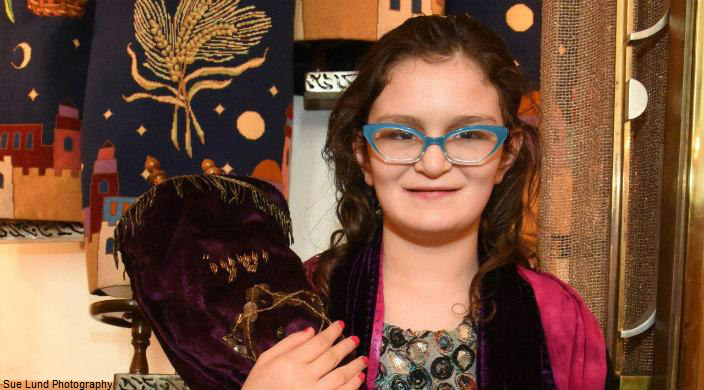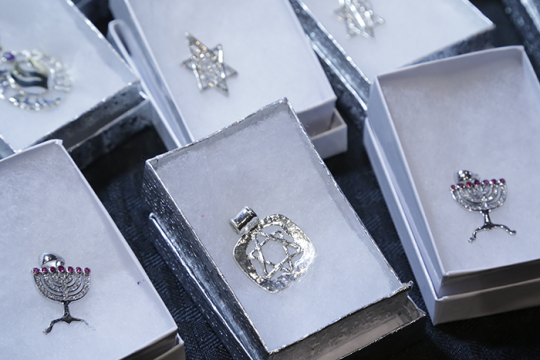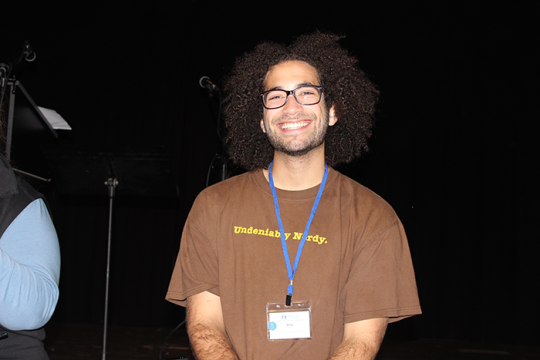
Everyone kept saying, “Whatever happens at Netta’s bat mitzvah will happen. It’ll be fine.”
I responded, “Of course it’ll be fine, and I will accept what happens, but only after we – her parents, teachers, and clergy – all share the same vision of Netta showing what she knows because Netta wants to show what she knows.”
As the mom of a child who has medical and developmental needs, I am experienced at keeping the balance between others accepting Netta for who she is and holding expectations high. We have learned that our daughter needs a floating bar for expectations… because just when we think the bar is high enough, she pushes it higher!
Earlier than predicted, her bat mitzvah tutor informed us that Netta had learned all the English readings the others kids learn, the blessings before and after the Torah and haftarah readings, and her Torah and haftarah portions. Her interest in and articulation of Hebrew was inspiring.
Six months before her bat mitzvah, Netta and I started studying the section she chose for her d’var Torah – V’ahavta L’reacha Kamocha, “Love Your Neighbor as Yourself.” We watched a G-dcast episode and YouTube videos, as well as studied scholars and sages, and we met with our rabbi, who offered suggestions.
As Netta struggled to construct paragraphs, I sat down to capture her voice – a voice we did not hear until she first spoke when she was 4½ years old. I decided to write a draft for her to edit.
And edit she did!
When I asked Netta to tell me which lines sounded like me and not her, she took joy in saying, “Ima, that sounds like you, not me.” Once three pages were deleted, she added specific words and phrases until the piece became her own – a process that took a week rather than the expected months.
We simulated a makeshift bimah (pulpit) at home using her reading stand and enlarged the print to 28-point font so she could read the words. Day after day, Netta practiced out loud. She decoded each word, made sure she had the correct pronunciation, and then initiated working on voice intonation. She was ready much sooner than we thought, once again surpassing our expectations.
Netta practiced in front of the rabbi privately and at a full dress rehearsal with a few dozen congregants. All did not go smoothly, but as the rabbi said, “We now know what we need to do.” Parents, teachers, and clergy all shared Netta’s vision. At the rehearsal the day before the bat mitzvah, we devised a backup plan to have the Hebrew portions on an iPad that we could hookup to the sound system if needed. Netta, although able to read the Hebrew fluently, had not yet done so in front of others, as she had the d’var Torah. The rabbi trusted she would recite it so we had no backup plan.
Our rabbi adapted the service so Netta could present her d’var Torah (an explanation or interpretation of a Torah passage; literally a word of Torah) before the Torah reading, face-to-face with her sibling Jasper, which worked at the rehearsal. Things started that Shabbat morning as we had practiced at rehearsal, but her words did not come. Jasper remained unflappable, and at one point, Rabbi Spilker stood up, with patience resonating in his voice, pace, and tone, as he said, "Netta, as we’re waiting, we’re all going to breathe because we all know that you have this in your heart. Some of us have had the honor of hearing you – and we know that once you get started we’re going to hear your words."
Then, something happened that I had never witnessed before. Three hundred and fifty congregants and guests sat and waited. For six minutes, no one stirred; no one made a sound.
And then, Netta’s words came.
“My favorite commandment is one that some – like Hillel 2,000 years ago – say is the most important one in the Torah: V’ahavta L’reacha Kamocha, ‘Love Your Neighbor as Yourself.’ But how do you love your neighbor as yourself? This is how I do it. Some of you might notice that I get excited when I meet new people. When I greet someone, I look in their eyes, introduce myself, and learn their name. I love to welcome neighbors and strangers to make them feel special. When I see the smile on their face after greeting them, it’s as if a piece of God is reflecting inside their soul.”
After she recited the Kiddush, Netta came down the steps from the bimah, threw her arms around me and said, “I did it! I did it.” To which I replied, “Yes you did, honey, yes you did.”
Netta’s delight – and ours, too – lingered.
A week after her special day, she joyfully told the cantor, “I want to do my bat mitzvah again!”
Watching the DVD of the bat mitzvah, my husband reflected on the significance of the number six, noting that it represents the days of creation, after which God created Shabbat – which Abraham Joshua Heschel explained metaphorically as a palace in time. “Netta, he said, “created a palace in time for all of us to hear her voice.” It is the voice we once thought we might never get to hear.
February is Jewish Disability Awareness and Inclusion Month (JDAIM), a unified initiative to raise disability awareness and support efforts to foster inclusion in Jewish communities worldwide. The Union for Reform Judaism is proud to partner with the Ruderman Family Foundation to ensure full inclusion and participation of people with disabilities and their families in every aspect of Reform Jewish life. Visit the Disabilities Inclusion Learning Center to learn more.
Related Posts

Six Symbols to Showcase Jewish Pride

